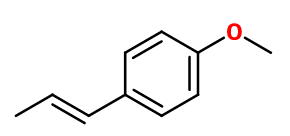
Photo credits: ScenTree SAS
| Company | Ingredient Name | ID | Comments | Naturality | Certifications | Purity | Latin name | Treated part | Geographical origin | MOQ |
|---|---|---|---|---|---|---|---|---|---|---|
|
|
Anethol Naturel - 30 Gr | - |
Visit website
|
- | - | - | - | - | - | |
|
|
ANETHOL | M_0050614 |
Visit website
|
Naturel | - | - | - | - | - |
General Presentation
-
CAS N° : 104-46-1 / 4180-23-8
-
EINECS number : 224-052-0
-
FEMA number : 2086
-
FLAVIS number : 04.010
-
JECFA number : 217
-
Appearance : Colorless liquid
-
Density : 0,983
-
Volatility : Head/Heart
-
Price Range : €€
Physico-chemical properties
-
Molecular formula : C10H12O
-
Molecular Weight : 148,2 g/mol
-
Log P : Donnée indisponible.
-
Fusion Point : 23°C
-
Boiling Point : 236°C
-
Detection Threshold : Donnée indisponible.
-
Optical rotation : Donnée indisponible
-
Vapor pressure : Donnée indisponible
-
Refractive Index @20°C : Donnée indisponible
-
Acid Value : Donnée indisponible.
-
Flash Point : 91°C
Uses
Uses in perfumery :
Anethole enhances fruity and floral notes by bringing a greener and more anisic facet.
Year of discovery :
Data not available.
Natural availability :
Anethole can be obtained by crystallization of Anise EO or Star Anise EO, Sweet Fennel EO or from Turpentine EO, among others. In the case of turpentine, a mixture of Anethole and beta-Caryophyllene is obtained. Then, Anethole is separated from the mixture by crystallization. Another fraction of this extraction contains both Anethole and Estragol. Therefore, a potash treatment is necessary to obtain a mixture of Anethole and alpha-Terpineol. These two molecules are separable by fractional distillation.
Isomerism :
The trans-diastereoisomer of Anethole is always the most present in its natural state. In perfumery, it is usually a mixture of the two isomers that is used. Estragole is a positional isomer of Anethole. Both molecules have an anisic note, but Estragole is more aromatic and green.
Synthesis precursor :
Anethole is a precursor to the synthesis of Anisaldehyde by oxidation.
Synthesis route :
The synthesis of Anethole is made by a Friedel-Crafts reaction using methoxybenzene and propionyl chloride. A hydrogenation followed by an acid treatment allows to obtain Anethole.
Regulations & IFRA
Allergens :
This ingredient is classified as an allergen under European Regulation 2023/1545, dated August 26, 2023.
Its presence must therefore be declared on product labels when it exceeds 0.001% in leave-on products and 0.01% in rinse-off products.
IFRA 51th :
This ingredient is not restricted for the 51th amendment

